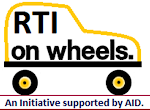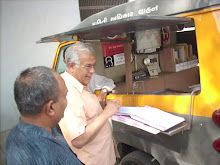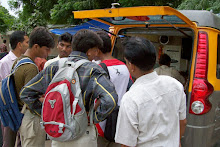Deccan Herald: Dakshina Kannada district: Sunday, May 27, 2012.
When endosulfan was first sprayed on cashew gardens in Dakshina Kannada district, not many knew that their lives would change forever. Today, villagers in the district are grappling with debilitating diseases and loss of livelihoods,writes Sushma Mohan
As a young village girl, catching fish was a favourite pastime for Baby Mahadeva Nayak. Now in her fifties, she vividly recalls the colourful species of fish that she would find in the stream near her house in Kokkada, a picturesque village in Belthangady taluk of Dakshina Kannada district.
But it all changed one day when some workers of the Karnataka Cashew Development Corporation (KCDC), engaged in aerial spraying of pesticide on the cashew plantations in the village, came to wash their containers in the stream. The next day, hundreds of dead fish, frogs, water snakes, crabs and other animals were found floating on its surface.
The helicopter that hovered over the village that day returned twice every year for the next 20 years. Even as Kokkada residents watched in fascination as the helicopter drenched the cashew plantations with pesticide, little did they realise that it was the harbinger of devastation.
The pesticide in question was endosulfan, an organochlorine pesticide and a toxic agrichemical. While acute endosulfan poisoning can lead to instant death in extreme cases, continuous exposure to it leads to life-threatening and debilitating diseases due to its capacity to disrupt the endocrine system besides tweaking genetic codes.
Karnataka’s story;
Aerial spray of endosulfan in Karnataka began in 1980 as a measure to control the tea-mosquito bug in cashew plantations of the KCDC. Thousands of hectares of cashew gardens in over 90 villages of the four taluks viz., Puttur, Belthangady, Sullia and Bantwal in Dakshina Kannada district were sprayed with endosulfan for almost two decades before it was stopped in the year 2000. The pesticide was also sprayed in cashew plantations in the other divisions of KCDC viz., Moodabidri, Kumta and Kundapur.
In neighbouring Kerala too, the Plantation Corporation there had resorted to a similar exercise in the border district of Kasaragod. Hundreds of cases of people living near the chemical-sprayed cashew plantations suffering from health complications were first reported in that state in the last decade. Dakshina Kannada district that has borne the maximum brunt of reckless use of endosulfan in Karnataka borders Kasaragod and shares with it a strong cultural, social and linguistic connection.
Yet, the administration and the people here were blissfully unaware of the tragedy unfolding in their own backyard. In 2009, the administrative machinery stirred for the first time to recognise the Kasaragod-like calamity being played out in the State. Some hurried surveys were conducted and a nominal compensation was paid to some of the victims.
Shree Padre, a well-known water journalist and a leading anti-endosulfan activist is a resident of Padre, a village in Kasaragod district that shares a boundary with Puttur taluk. As an active witness to Kerala’s fight against endosulfan, Shree Padre is dismayed with the general apathy in Karnataka over the issue.
“Even a rickshawalah in Kerala will talk to you for at least half an hour on the dangers of indiscriminate use of pesticides thanks to the public awareness there about the horrors of endosulfan. But it is frustrating to see the lack of such a spirit among the people here,” he says.
Padre is one of the highly affected villages where endosulfan has claimed many lives in the recent years.
Unsung heroes;
All is not lost though. Youths like Shridhar Gowda and Sanjiva Kabaka have been dedicatedly working towards getting justice for the endosulfan-affected families in the State. Though unprotected exposure to endosulfan stole the light from his eyes at the young age of 14, Shridhar Gowda has succeeded in making others see the magnitude of the tragedy in his village of Kokkada, which, along with the neighbouring Nidle and Patrame villages, has the maximum number of reported cases of endosulfan poisoning in Dakshina Kannada district.
After endosulfan spraying started in Kokkada, the village saw a sharp increase in the number of health complications, but the villagers could not ascertain the reason behind it. In the following years, instances of cancer, skin problems, infertility, etc increased and hundreds of mentally and physically deformed children were born as people tried to grope for answers.
It was in the last decade when reports of similar happenings in Kasaragod started appearing in the local media that Shridhar Gowda was curious about the connection between endosulfan and the diseases plaguing the people of Kokkada. He started a postcard campaign in 2005 to draw the attention of the then President APJ Abdul Kalam on the plight of endosulfan victims in his village. The campaign led to a hurried survey by the health and revenue departments in the region which identified 251 people as suffering from long-term illnesses.
“The survey was clearly inadequate because in Kokkada itself we have more than 1,000 endosulfan victims out of whom 30 are cancer patients,” says Gowda. In 2009, the then chief minister Yeddyurappa came to the village to hand over compensation of Rs 50,000 each to 211 suffering families.
Inspired by Shridhar Gowda’s work in Kokkada, Sanjiva Kabaka of Puttur, an RTI activist and a member of Consumers’ Rights Forum started to file RTI applications about various aspects of the aerial spray of endosulfan in the district. A sixth standard dropout and a daily wage worker at a local industry, Sanjiva’s RTI campaign brought to light many shocking truths about how mandatory precautionary measures were skipped while spraying endosulfan in the district.
He wrote to the Governor and lodged a complaint with the Human Rights Commission following which a survey was conducted in Puttur to identify endosulfan victims in the taluk where many villages like Alankaru are severely affected. “According to the documents I have obtained under RTI, aerial spraying of endosulfan happened in Bhatkal and Honnavar too, but due to lack of awareness among people the cases remain unexposed,” Sanjiva laments.
More than 80 countries in the world have already banned endosulfan and in India too, the Supreme Court intervened last year to ban the production and sale of endosulfan. Apparently, India is the world’s largest customer of endosulfan with more than 80 pc of the total production of the pesticide being used here on crops like cotton, tea, cashew apart from fruits and vegetables.
While the RTI documents sought by Sanjiva say that the aerial spraying of endosulfan was stopped in Dakshina Kannada district in 1994, in reality, the spraying continued in several places till the year 2000. Besides, the ground spraying continued unhindered for a long time afterwards. Despite the Supreme Court ban, endosulfan has entered the market in a different name and is said to be freely available in shops across Karnataka!
How it affects humans;
While research by Dr Mohammad Asheel, an anti-endosulfan activist in Kerala links more than 140 diseases to endosulfan poisoning, the common illnesses that are found among those subjected to its long-term exposure include physical deformity, cancers of the liver, breast, uterus, blood and throat; hormonal disturbances, respiratory problems, skin diseases, infertility, gynecological problems, central nervous system disorders like cerebral palsy, epilepsy, mental retardation, Parkinson’s disease, depression among others. Shridhar Gowda recounts the horrific incident in Kokkada many years ago when two school children died after consuming the cashew blossoms that were sprayed with endosulfan.
Was care taken ?;
It is mandatory that the people living near the plantations (where aerial spraying of the pesticide will be taken up) should be educated about the measures to prevent unprotected exposure to the chemical. Nearby schools and colleges have to be closed on the day of spraying and people and animals should be prevented from entering the sprayed area for the next 10 days. Wells and water sources have to be adequately covered to prevent contamination.
The spraying should not be done when the wind velocity is high while helicopter engines should be shut 100 metres before the borderline to prevent the sprayed particles from spreading to unintended regions. But these precautions were not followed by the KCDC except for publishing announcements about the spraying period in local newspapers, that too for a couple of years initially, and it was later abandoned.
“They wouldn’t give the exact date when the aerial spraying would be done. Besides, how could they expect illiterate villagers to read the papers and understand the implications of unprotected exposure to endosulfan,” asks Dr Mohandas Gowda, a doctor from Kokkada who admits that the village has seen a sharp rise in patients suffering from many life-threatening diseases since 1980. He recalls how farmers, unaware of the disastrous nature of endosulfan, would buy it at the helipad itself for use in their plantations.
According to manufacturers, traces of endosulfan cannot be found after three weeks, but in reality even 10 months after the spraying was done, it could be detected in water and soil. All these places receive more than 3,000 mm of rainfall per year, and one can imagine the penetration capacity of the pesticide in such a scenario. Pesticide firms argue that the chemicals are safe except for the lethal dose. But how does one define the lethal dose? “If pesticides don’t kill humans but render them immobile, infertile and make them suffer with diseases like cancer, is it acceptable?” asks Shree Padre.
Heart-wrenching stories;
A walk around Kokkada is enough for one to assess the gravity of the situation. Endosulfan-affected families greet you with anxiety writ large on their faces. The trauma of the victims’ family members is equally grave. “My husband committed suicide as he was unable to cope with our son’s condition,” says mother of Baby, a young endosulfan victim confined to bed. She struggles to make ends meet as the monthly compensation that her husband was getting on behalf of her disabled son has been stopped since the former’s death.
In the last decade, over 20 victims from the village have chosen to end their lives rather than endure their fate, points out Shridhar Gowda. While endosulfan has affected people of all ages, it’s those children like Kokkada’s Santhosh Minezes, who were born after the aerial spraying began, who are most affected. Santhosh, 22, has been confined to bed from the time he was nine months old. Unable to speak or move, he communicates with his mother through feeble groans and grunts.
When his mother was pregnant with him, the cashew garden surrounding their house was being sprayed with endosulfan. Such stories abound in many villages of Dakshina Kannada district where endosulfan has left a bloody trail of devastation.
One in six houses in Kokkada, which has a population of 6,000, has its members suffering from either direct or indirect effects of endosulfan. However, government compensation has been distributed only in Kokkada and not in other places. Apart from losing hundreds of cattle to mysterious diseases in the last two decades, the villagers of Kokkada also say that snakes, frogs, fish, butterflies and vultures have almost disappeared from the village post-spraying.
Surveys conducted by scientific research organisations in Kerala found that endosulfan had greatly contaminated soil and groundwater and in some cases its residue found in human blood was as high as 18 times that of the contaminated water! The movement against the deadly pesticide is now slowly gaining ground in Uttasta Kannada district too where people are pressing politicians to order a thorough survey in the district.
Poor rehabilitation;
What has come as a double blow for endosulfan victims is the fact that the administration is dilly dallying over providing compensation and rehabilitation support citing lack of evidence to prove endosulfan’s role in their misery. “Wherever this poison was used continuously for longer periods, the story has been the same.
The victims are suffering from similar diseases everywhere and the samples from these regions have proved endosulfan’s presence in soil, water and blood. Besides, there are no major industries in these regions. But these facts are not convincing enough for our politicians to take a firm stand against such pesticides,” say the affected.
In Kokkada, the administration has set up a day care centre catering to 33 endosulfan victims from the region. A physiotherapist, teacher and two helpers work to bring some relief to the patients suffering from various physical and mental illnesses. According to Ramya, a teacher at the centre, cerebral palsy is the most common condition among the majority of children here.
It is crucial that farmers are educated adequately about the hazardous nature of the
chemicals they use for growing and protecting their crops. People in Kokkada remember how some people would shift the red flags placed by the KCDC workers to mark the cashew plantation boundaries so that their crops too could get sprayed with endosulfan for free!
From the stage of production till it finally reaches the consumer, our food is contaminated at every stage with chemicals and we conveniently ignore the amount of poison we inject ourselves with each day in the name of food. “Believe it or not, there is not a single lab in the whole of Dakshina Kannada district to detect food contamination, if RTI documents are to be believed,” says Sanjiva Kabaka.
The wait for justice has been a long and tedious one for the victims of endosulfan in the State and the administration cannot afford to ignore them for long.














































































